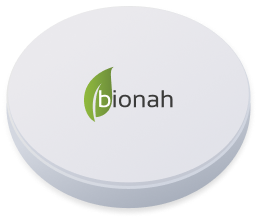Zirconia is a mineral with a crystalline structure, which can be found frequently in the earth’s crust. It is also known by its classical term zirconium silicate (ZrSiO4). Amongst other uses, zirconium silicate is best known in the jewellery industry as a gem stone alternative to diamonds and is used to produce the metal zirconium. In dental technology, the term zirconia is used to describe the dental material zirconium dioxide.
Hydrothermal ageing
In the course of the discussion about strength, material ageing is also a topic. Every material suffers from material fatigue after a certain period of time, including BionZ zirconium oxide. In addition to this, the added constituent yttrium oxide reacts to a humid and warm environment and no longer has a positive effect on structure stability. In order to counteract this problem, a small percentage of aluminium oxide (Al2O3) is added to the Bionz material. Hydrothermal ageing will not occur, as zirconium oxide is inserted into the mouth in an “encapsulated state”. Direct contact with moisture is prevented on the outer surface due to the porcelain veneer and on the inside due to the cement.
The self-healing effect
The advantage of BionZ in comparison to other ceramics (such as aluminium oxide) lies in its relatively low brittleness. If a crack should occur in zirconium oxide, crystal lattice transformation will prevent the crack propagating — the tetragonal phase converts to a monoclinic structure causing an increase in volume at that point. This is known as the so called self-healing effect.
The strength value
After studying the details it is understandable why Bionz frameworks are so strong. Of all the mechanical properties stated for materials, only a few are relevant in dental technology. These are the flexural strength, the related Weibull modulus and the coefficient of thermal expansion (CTE). The Weibull modulus determines the distribution of the calculated strength values. A low Weibul modulus value shows a wide distribution of strength. A high value shows a low distribution. The Weibull modulus value should therefore always be considered in combination with the flexural strength value, otherwise the values are not immediately comparable. On this topic, the different measuring methods to determine the flexural strength should also be considered (bi-axial flexural tests, 4-point measurements, 3-point measurements). The test procedure and the surface quality both influence the test results.



